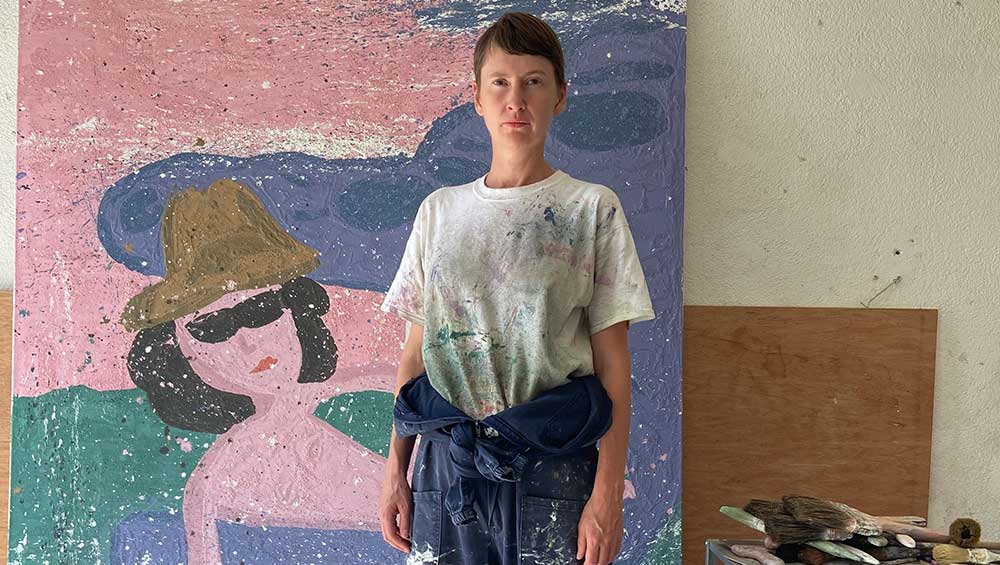
Kate Groobey, Photo courtesy of the artist and Sim Smith London.
by ANNA McNAY
Kate Groobey (b1979, Leeds) combines painting and performance to break down barriers between her audience, her protagonist and herself as performer. For her latest series, Female Stallion, which comprises six large canvases with their associated soundtracks and performances, her muse is her wife, the writer and poet Jina Khayyer, and her purpose is to create a safe, feminine and queer space, which might ideally make people feel inspired, stronger and more empowered.
Groobey, who studied at the Ruskin School of Drawing and Fine Art, University of Oxford, and the Royal College of Art, London, was the first woman to win the prestigious Daiwa Foundation Art Prize in 2018. The ensuing residency in Japan provided plentiful inspiration for her work, as have her many other encounters with different cultures and languages. It is perhaps unsurprising that the mouth – and lips and tongue – are common motifs and focal points in her paintings.
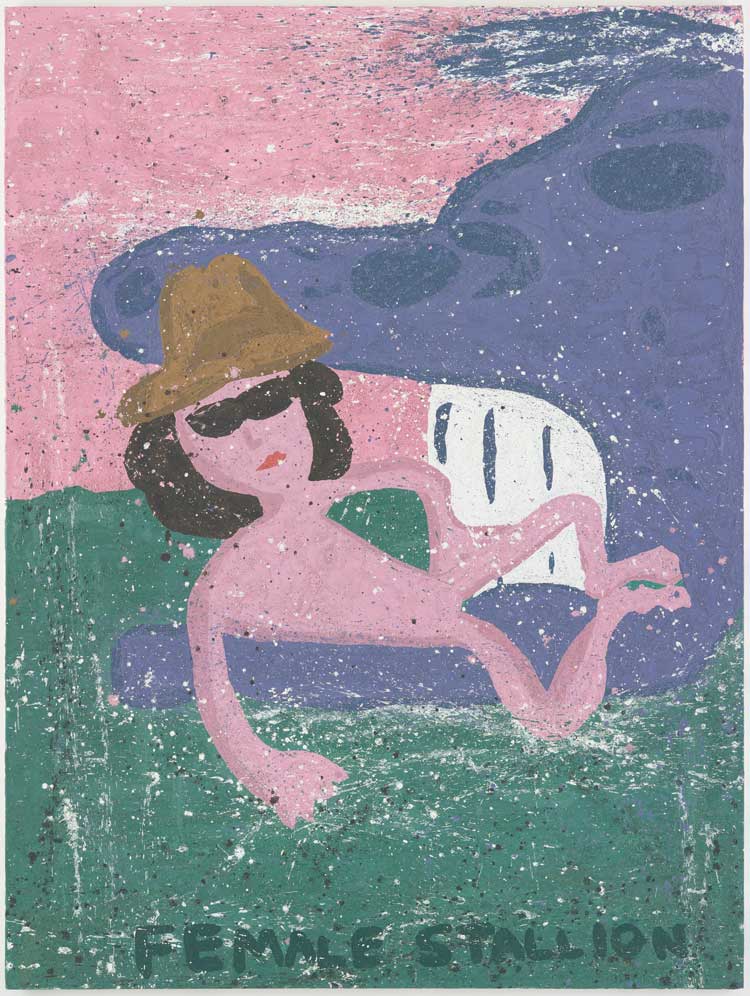
Kate Groobey, Female Stallion, 2022. Oil on canvas, 200 × 150 cm (78 ¾ × 59 in). Copyright the artist. Courtesy of the artist and Sim Smith London.
In her performances, the protagonist literally steps out of the canvas, as Groobey dresses as, embodies and becomes her character. Both the performances and the paintings are full of vigour, and her unencumbered gestural style is energetic and dynamic.
In this Zoom interview for Studio International, Groobey talks about her process, her inspirations and the importance of painting as a means of communication.
Anna McNay: I want to start with the description of the works in your current exhibition, Female Stallion, on the gallery ’s website. It reads: “There are six large oil paintings in Groobey’s new painting series Female Stallion with accompanying performances that see the paintings brought to life by Groobey herself, who dresses up as her character in painted costumes, performing improvised dances in front of painted backdrops to music of her own creation.” This sentence is pretty breathtaking – both in its scope, but also literally because, to be exhaustive, it has to be so long. If you had to condense it a little, how would you describe yourself as an artist?
Kate Groobey: I’m a painter. I began with the performance in 2015, around the time I moved to Paris, when I met my wife, the writer and poet Jina Khayyer. I didn’t have a studio to begin with, because moving from London to Paris, it took me a while to find my feet. The idea of dressing up as my paintings came to me as I asked myself what I could do, what I could make, in that period. This was something I could do in the apartment. But the idea of a painting coming to life had established itself much earlier, probably even in childhood. There is a little girl, Erica, who becomes trapped in a painting in Roald Dahl’s The Witches. And I had read the Harry Potter books with the moving portraits as well. So, I think those ideas were embedded. There is an excitement for me in activating my paintings. They are already very physical. I have always liked to make big paintings. This was the next step, really.
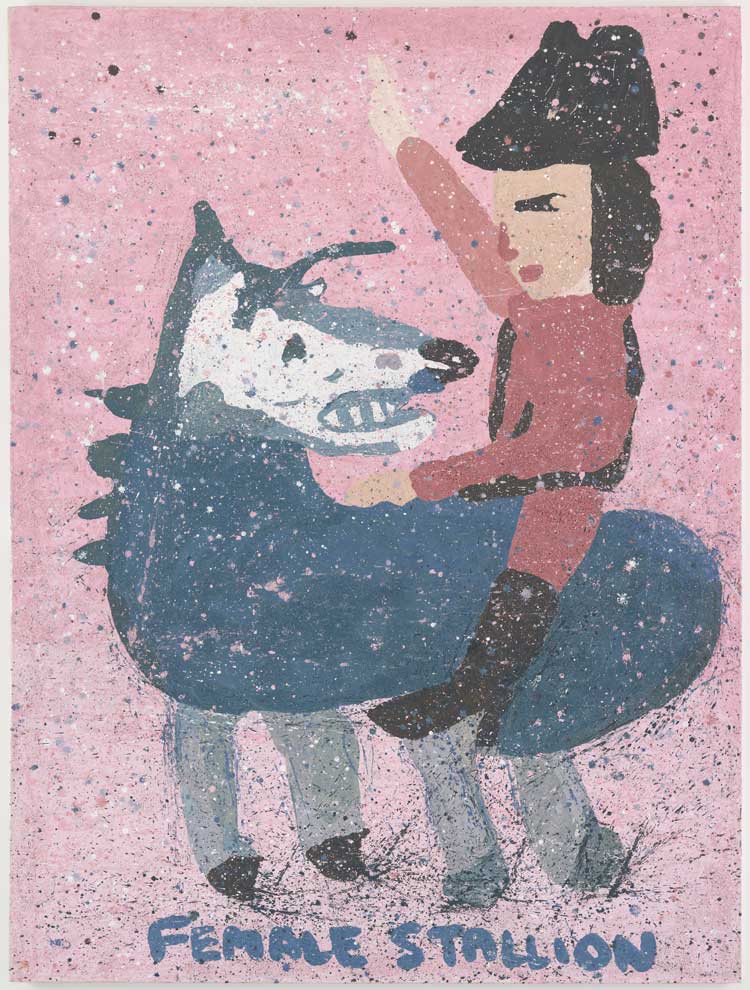
Kate Groobey, Female Stallion, 2022. Oil on canvas, 200 × 150 cm (78 ¾ × 59 in). Copyright the artist. Courtesy of the artist and Sim Smith London.
AMc: Do you now create the performance at the same time as the painting, or does the painting still come first?
KG: It’s more comfortable for me to make the oil paintings first. But, before these, come the watercolours. That’s really how I think through my ideas. And then the editing process begins, where I start to think about how I might create a series or a connected body of work from the ideas. I like to produce a lot of ideas in watercolour, and also as drawings. Then I start to conceptualise them and select those which could turn into large paintings and performances. Normally, one series will comprise between six and 10 paintings.
AMc: I was going to ask you about the series and whether they exist in your mind before you make the works, or appear as these accumulate. Are you saying you conceive the series first?
KG: The drawings come first, but they are very much from my subconscious. I’m not really thinking at that point. I have a big box of drawings. Then I start with the watercolours, which are somewhere in between drawings and paintings. I will maybe spend six months just making watercolours. Then, at the end of that time, I look through them and start to edit. I think through what’s happening in them and what the main ideas are. I ask myself how I can select between six and 10 images to create something that can turn into a series or a show. The concept is then slowly developed over a couple of years. I might start with just one image, and then, after I have painted that, see how I feel. It can change. It’s not necessarily the case that I select six, and it stays as that six. I might re-edit – reselect – based on how I feel after I have made the first one.

Kate Groobey, Be In Bloom, 2022, Oil on canvas, 195 × 150 cm (76¾ × 59 in). Copyright the artist. Courtesy of the artist and Sim Smith London.
AMc: It sounds as if you create a form of Gesamtkunstwerk [a total work of art] with your series – in fact, even with each painting and associated performance. Do the paintings stand alone, or are the performative elements imperative?
KG: They are conceived together, and they are the most powerful when they are shown together, but, once they are out in the world, they can go their own way.
AMc: I don’t know if this is the same for all your series, but, for Female Stallion, some of the paintings were inspired in part by things you had heard being said. Do you note down words and snippets of conversation while you are in your drawing or watercolour stages?
KG: Quite often, yes. Jina might say something, and I will go and grab a piece of paper. I might then sit and play around with how to manifest it into a visual. There is no one way of doing things, but that ’s how I have been working for quite a few years now. A lot of my paintings come from someone just saying something which sticks in my mind.

Kate Groobey, I Like To Lick, 2022. Oil on canvas, 195 × 150 cm (76¾ × 59 in). Copyright the artist. Courtesy of the artist and Sim Smith London.
AMc: Maybe connected to this, a lot of the imagery in the Female Stallion series is related to the mouth. Is this symbolic? I Like to Lick certainly has innuendo in it.
KG: There is sexual innuendo, yes. But, also, I moved to France, not speaking the language, because Jina lived here. We did it at school, of course, but I wasn’t a high achiever in French class. I’m trying to learn it now and really starting from scratch. But painting is a form of communication, too, and so these ideas all mixed together in my mind. It all centres on the mouth, because it has to learn to make new shapes in French. In order to speak the words, I have had to build new muscles. When I first tried to say certain things, my mouth just wouldn’t function as necessary. So, even just on this very basic physical level, the mouth is interesting.
AMc: What took you down to live in the rural south of France?
KG: I was living between England and Paris. Then there was the Bataclan attack. Jina has a Middle Eastern background. She was born in Germany, but she’s Iranian, and so it really hit her hard. The year 2015 was a year of turmoil in many ways, and we started questioning how and where we would like to live. We went on a two-year living-and-working-on-the-road mission, where we exchanged work for accommodation, to explore our possibilities. Jina always had a sweet spot for the south of France – one of her best friends has a family home here in Provence – so we looked, found and moved.
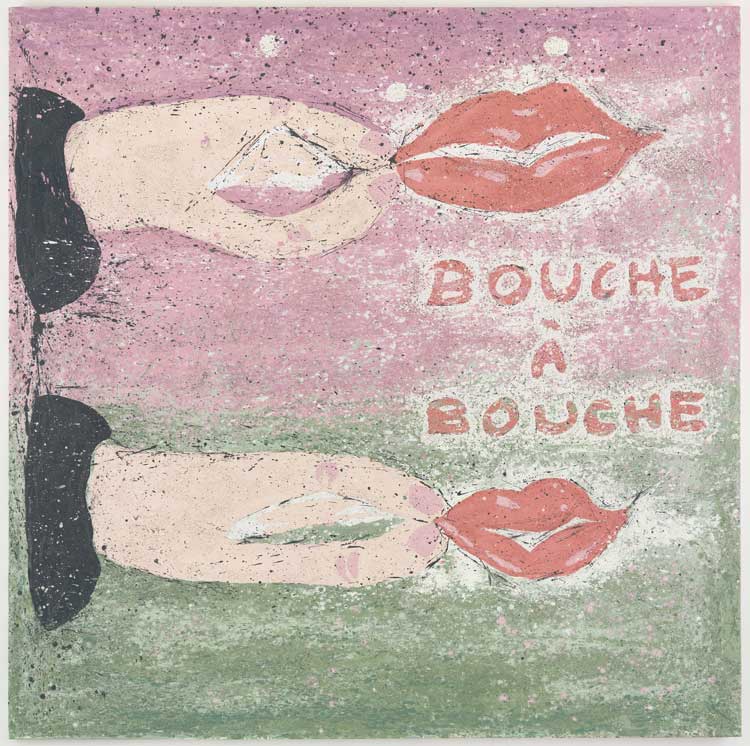
Kate Groobey, Bouche À Bouche, 2022. Oil on canvas, 200 × 200 cm (78 ¾ × 78 ¾ in). Copyright the artist. Courtesy of the artist and Sim Smith London.
AMc: Does where you are affect your work – beyond the linguistic input we have already spoken about?
KG: Yes, definitely. The textures of Provence have entered into my work. The way I make the paint now is very thick, very textured, bubbling. You can’t really see it in photos. This comes from everything here being made from limestone, or covered in lime mortar, which, over time, develops thick textured patinas. Of course, the culture also enters into my work. Bouche à Bouche is my first French performance, with Jina’s voice on the soundtrack. And the light of the Luberon is very special, very white. That’s why all the great artists came here – Picasso, Matisse, Van Gogh.
AMc: We have already mentioned the sexual innuendo in I Like to Lick. Then there is Get Into My Rainbow, which also makes use of a motif recognisably associated with lesbian and gay pride. How important is your sexuality – and autobiography – in your work?
KG: Autobiography has become very important. After my father was diagnosed with cancer, I realised I had to address that topic in my work. It was the only way I could make anything meaningful. I hadn’t made such explicitly autobiographical work before that. It was maybe there in the undertones, but not so directly. Now, whatever the main feelings or events are in my life is what goes into the work. For each series, it’s a question of what is important to me while I’m producing the work.
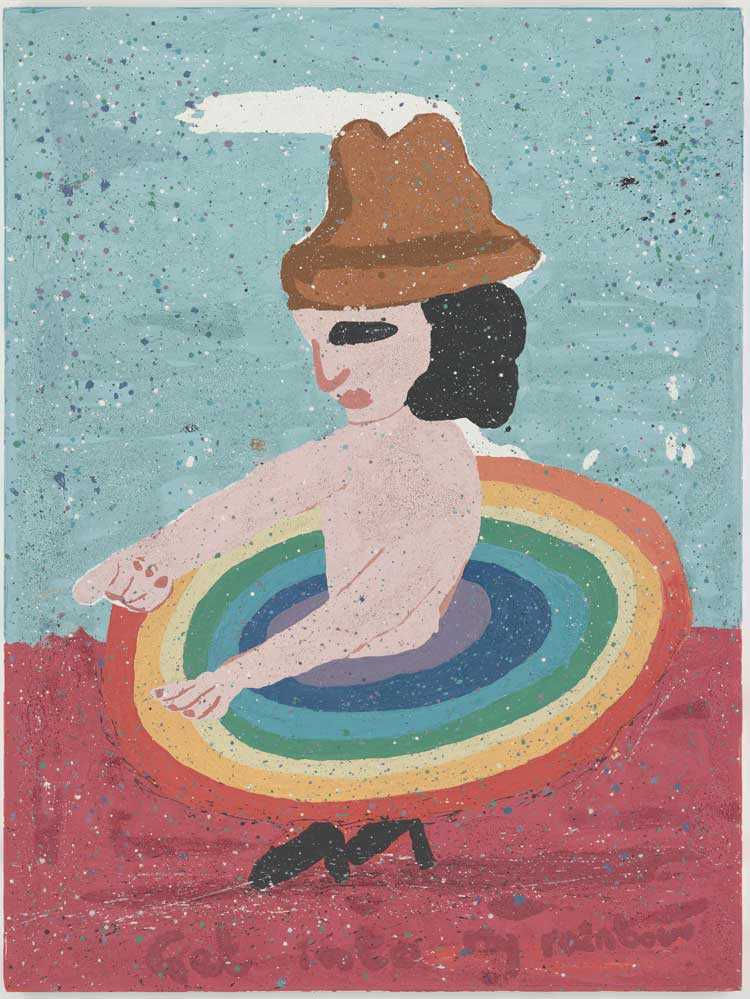
Kate Groobey, Get Into My Rainbow, 2022. Oil on canvas, 200 × 150cm (78¾ × 59 in). Copyright the artist. Courtesy of the artist and Sim Smith London.
AMc: What was important to you while you were creating the Female Stallion series? There are so many influences that come together here.
KG: One show that really helped me crystallise what I wanted for this exhibition was Pure Pleasure, which was shown at the Ikon Gallery in Birmingham and the Mizuma Gallery in Tokyo, in 2018. I had a lot of response from the public, who sent messages saying how inspiring the show was, and how good it made them feel. That was quite special for me, that a show I had made could really inspire people. Part of what I wanted for this show was to create a really beautiful, safe, feminine and queer space, which could inspire others and make people feel a bit stronger or a bit more empowered.
AMc: You say you wanted to create a“feminine and queer space”. You’re a female painter with a female muse. What is your take on the male gaze? Are you deliberately trying to subvert it?
KG: As a figurative painter, I have to engage with it and ask myself questions. If I do certain things in my painting, what is the difference? I’m not sure I have the answers, but I think it’s important to be aware and to ask those questions.
AMc: I guess, for example, you use the drip a lot in this series. I know you like Jackson Pollock, and his drip painting has sometimes been likened to ejaculation. What is the drip for you?
KG: The drip, for me, is pure joy and a kind of thrill. That’s what brought me to painting as a teenager: the thrill of paint, the thrill of colour, the thrill of the substance. I’m adopting the drip as a female-desiring gesture.
AMc: How do you paint on a more practical level? Do you have the canvas on the wall, on an easel, or on the ground for the drip?
KG: It has to be flat on the ground. I’m usually standing in it, or over it. It’s an immersive process where I’m very much in the midst of all the colour and all the mess.
AMc: Is that for the whole painting, not just the drips?
KG: For the whole painting. It’s painted very wet. The paint is liquid.
AMc: How long do you spend working on one canvas, if you need to keep the paint liquid?
KG: There’s a lot of groundwork preparing the canvas, but the actual painting, ideally, is one day – a long day. It can go over to two days. It’s really performative. It’s this big release of energy. And that’s exciting for me.
AMc: It completely makes sense, then, that the performances are you coming out of painting.
KG: Yes, they echo each other. The live performances, and the video performances, give a feel of this explosion of energy and excitement.
AMc: With Jina’s voice on the soundtrack, your body performing and your painted work it must feel somehow uniting?
KG: There is a mixing of bodies. This is the first time we have used her voice on the soundtrack.
AMc: Can you say something about the 14th-century Japanese performance style known as Nō theatre, which you encountered first-hand when you travelled to Japan in 2018 for the Daiwa Prize Residency? You draw on this influence for even further “coming together” in your work.
KG: The idea of Nō is that the members of the audience have to do a lot of work. They aren ’t passive. They have to enter into the work and really get into the psychology of the character and the person performing. The performer shouldn’t just imitate the character but should “become” them. They give their self over to the character. There is a coming together of the audience, the character and the performer and an illusion of there not being any barriers between them. I think this is quite relevant to my subject and to a time when people are trying to break down barriers and walls between them. It is really an invitation to be open to change your perspective, your subject position, and to enter into someone else’s world. I think that is what is behind it for me.
AMc: As you say, it’s painting – and your wider practice – as a form of communication. Especially with the repetition of words and phrases in the soundtrack. It’s a bit like learning a language and having to repeat something over and over.
KG: I hadn’t thought of it like that, but yes.
AMc: Can you say anything about the concept of a “female stallion”? Where did that come from?
KG: It’s a moment from our everyday life. Every morning, Jina and I go running together. As we live in the countryside in the south of France, there are a lot of animals around. Our neighbours have two horses and two donkeys. Every morning, we see the two horses. There’s a yellow male horse and a black female horse. For a long time, I thought the black horse was the male, because she was so alert and almost aggressive in her mannerisms. She would shake her head at us, snort, and sometimes go up on her back legs. One day, Jina said: “This is a female stallion!” That then became our way of describing any kind of strong woman, and it felt like it should be the title piece of this show.
• Kate Groobey: Female Stallion is at Sim Smith, London, until 5 November 2022.
Click on the pictures below to enlarge